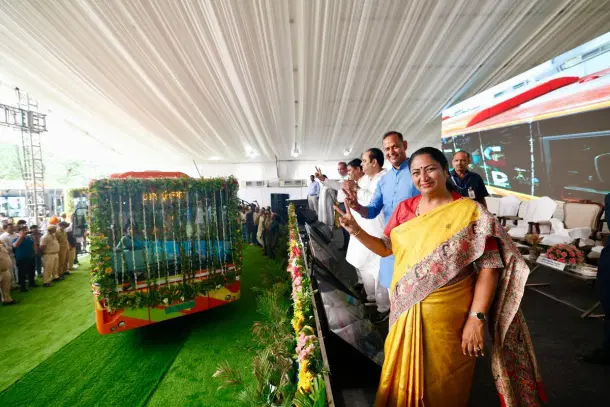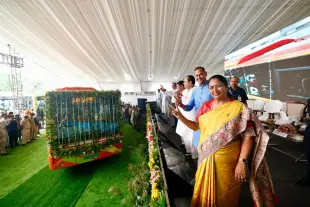Commentary
The Double-Engine Test: Delhi's Inherited Crises And The Burden Of A Unified Mandate
Kishan Kumar
Jul 27, 2025, 10:06 AM | Updated Jul 28, 2025, 10:47 AM IST
Save & read from anywhere!
Bookmark stories for easy access on any device or the Swarajya app.


Delhi, the capital of the world's largest democracy, has long been a theatre for the promise and paradox of Indian urban governance.
In early 2025, the stage was reset. With the Bharatiya Janata Party (BJP) sweeping to power in the state assembly and taking control of the municipal corporation, a new political script was introduced. The era of the “double-engine sarkar,” a synergy between a unified local and central government, arrived with the assurance of ending gridlock and fast-tracking development.
However, the summer of 2025 has delivered a harsh dose of reality. The city's chronic ailments, power outages, water shortages, and the ever-present threat of urban flooding have not magically vanished. These are not failures of a government merely months into its term; they are deep-seated, systemic crises inherited from decades of multi-party rule, political inertia, and fragmented planning. The “double-engine” is not being judged on its performance yet, but on a far more fundamental question: can this celebrated model of governance succeed where all others have failed? Can it fix a system that appears structurally broken?
The data paints a grim picture of the inheritance. Delhi's electricity demand, which hit a record 8,656 MW in 2024, continues to push the grid to its breaking point.
An astonishing 58 per cent of the city's treated water is lost before it ever reaches a tap. And the city's primary defence against flooding is a drainage plan conceived in 1976 for a population of just six million. This is the challenge the new administration faces, where the political victory of unification meets the hard reality of infrastructural decay.
As a punishing summer blankets North India, Delhi's power infrastructure is once again buckling under the strain. This is not a new phenomenon, but an annual ritual that exposes the fragility of the city's electrical grid. The success story of the post-2002 privatisation of distribution has reached its structural limit, a problem that now falls squarely on the new government's shoulders to solve.
The city’s peak electricity demand continued to flirt with the record of 8,656 megawatts (MW) set in 2024. This isn't just a number on a chart; it translates into blackouts and voltage fluctuations across the city. The core of the crisis is a legacy of chronic underinvestment in resilience. For years, capital expenditures by discoms have prioritised expansion into new colonies over fortifying the existing grid. As a result, critical components like transformers and feeder lines are old and overloaded. Redundancy, backup systems, and modern solutions like battery storage remain largely on paper.
For the new government, the challenge is twofold.
First, it must compel the private discoms to make the long-overdue capital investments in upgrading the grid's backbone.
Second, it must navigate the complex regulatory environment of the Delhi Electricity Regulatory Commission (DERC) to ensure that tariff structures incentivise resilience without unduly burdening consumers. The “double-engine” promise of frictionless coordination will be severely tested here, as it confronts a private sector and a regulatory framework accustomed to a different political dynamic. The blackouts of 2025 are not the new government's fault, but the responsibility to prevent them in 2026 is now entirely theirs.
No issue better illustrates the institutional inertia plaguing Delhi than its struggle with urban flooding. Every monsoon, the city is brought to a standstill by waterlogging, a problem rooted in a drainage system that is tragically out of date. The city is currently operating on a drainage master plan designed in 1976, when Delhi's population was a mere 6 million. Today, with a population exceeding 30 million, that same system is expected to handle numbers it was never built for.
The story of replacing this plan is a saga of bureaucratic and political paralysis that has spanned three different governments. The process began in 2011, when the then-government signed an MoU with IIT Delhi. After seven years, IIT Delhi submitted a draft master plan in 2018. However, in 2021, a technical expert committee advised the government to reject the plan, calling it too “generic” and lacking “clear-cut actionable points.”
Later that year, the Public Works Department (PWD) was made the nodal agency to formulate a new plan, using the IIT Delhi report as a base and dividing the city into three major drainage basins. Yet, progress remained slow. It was only in May 2023 that the PWD appointed a consultant for the largest of the three basins, Najafgarh. That report has only recently been submitted. Meanwhile, bids to appoint consultants for the remaining two basins, Trans-Yamuna and Barapullah, have just been floated, with reports expected soon.
For nearly fifteen years, a critical piece of infrastructure has been caught in a cycle of studies, rejections, and delays. The new BJP government has inherited this stalled process. Its challenge is not just to finalise a plan, but to demonstrate that a unified governance structure can cut through the red tape that has entangled this project for over a decade and finally give Delhi the modern drainage system it desperately needs.
The water crisis of summer 2025 follows a familiar, painful script. Against a daily demand of 1,290 MGD, the city struggles to supply even 1,000 MGD. This scarcity is exacerbated by the shocking inefficiency of the Delhi Jal Board (DJB), which loses 58 per cent of its treated water to leakages, theft, and unmetered connections. This is not just a waste of a precious resource but a colossal financial loss.
The crisis is compounded by Delhi's dependence on neighbouring states for over 80 per cent of its raw water.
Interstate disputes over water sharing are a chronic feature of Delhi's existence, and they persist regardless of which party is in power. The new BJP government in Delhi, led by Chief Minister Rekha Gupta, now has the delicate task of negotiating with its own party's governments in Haryana and Uttar Pradesh. This will be a true test of the “double-engine” theory, whether shared party affiliation can resolve deep-seated regional interests over water resources.
For the citizens queuing for tankers, political theory matters little. They see a government that, despite its unified mandate, is still struggling to deliver the most basic of necessities. The new administration's task is monumental: it must undertake a complete overhaul of the DJB, plugging decades-old leaks and modernising its distribution network, while simultaneously navigating the treacherous currents of interstate water politics.
In previous years, Delhi's governance was defined by a “triple-blame game,” where the Centre, the state government, and the municipal bodies could all point fingers at each other. The 2025 mandate has eliminated that possibility. With the BJP in control of the state government under CM Rekha Gupta, the MCD under Mayor Raja Iqbal Singh, and the Centre, the carousel of blame has stopped. There are no more excuses.
This presents both an opportunity and a peril. The opportunity is to govern without the friction and political opposition that plagued previous administrations. The peril is that there is no one else to hold responsible when things go wrong. Every power cut, every dry tap, every flooded street is now a direct reflection on the performance of a single, unified government.
The crises of 2025 are not the BJP's creation, but they are now its burden. The party campaigned on the promise that a “double-engine sarkar” was the antidote to Delhi's problems. The coming years will reveal whether this model can truly overcome the decades of institutional decay, infrastructural neglect, and bureaucratic inertia that have left the capital so vulnerable. Delhi is weary, but it is watching. The test of the double-engine has begun.
Kishan Kumar is a graduate in Economics from the University of Delhi, currently working in the political communication space. He focuses on narrative-building, strategic messaging, and public discourse, with a strong interest in politics, policy, and media. He posts on X from @FreezingHindoo.





